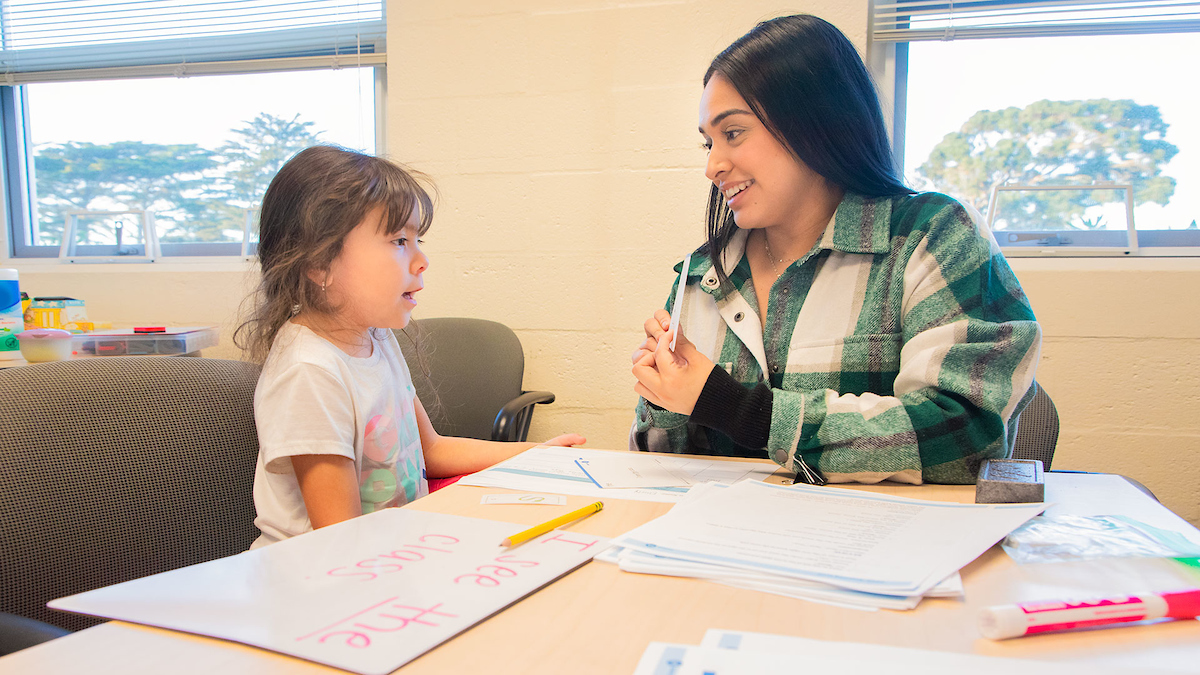CSUMB’s Reading Center has a long history and a hopeful future

Ashley Arango, right, works with Emely Hernandez at the CSUMB Center for Reading Diagnosis and Instruction. | Photo by Mark Muckenfuss
February 12, 2024
By Mark Muckenfuss
When Jesus Hernandez noticed his daughter, Emely, was having trouble with learning her ABCs and basic shapes, he knew Cal State Monterey Bay could help. His older daughter, Ingrid, now 17, had struggled with some learning difficulties when she was in grade school. She’d been helped by the CSUMB Center for Reading Diagnosis and Instruction.
“I saw a lot of progress,” Jesus said. “I saw her becoming much better in the school. That’s why we brought Emely.”
In the short time that she has been coming to the center, Jesus said Emely, 5, has learned all of her letters and is enjoying preschool more.
Scott Ross, director of the center, said the program, which began in 2007 and serves local school children, is beginning to see a second generation of students, with parents who were once helped by the center bringing their children in for reading assistance.
“The big role for the center is serving the local community to help struggling readers,” Ross said. “It all comes down to helping kids learn to read.”
The center, which Ross said is self-sustaining, also serves as a stepping stone and training ground for future teachers and school psychologists. He said the 40 teachers and interventionists working there are “all working on special education credentials, master’s in school psychology or doing service learning.”
The work they do can not only change the lives of the students they’re working with, but their own as well.
Irene Moulton, office manager for the center, said she’s seen many students who come in to do their service learning at the center, fall in love with teaching and change their course of study to become educators. She doesn’t think that’s surprising given the transformation she sees in many of the clients.
“A lot of kids come in with low self-esteem, with their heads bowed down, not saying anything,” she said. “But after a while their heads are held high, they’re talking and having fun with the interventionists.”
Ingrid Hernandez said she was one of those kids. The teen was just 7 when she first came to the center.
“I didn’t really like reading,” she said, adding that, as a result, she was doing poorly in school. “But after coming here, I started to like it. To this day, I like it and I read books on my own. I like to read thriller mysteries.”
Ingrid said she reads between one and 1½ hours per day and gets As and Bs in her high school classes.
Making that difference happens one word at a time.
At the center, Emely works with Ashley Arango, who is in her first year of the school psychologist master’s program. On a recent Monday, the two sat at a desk where Arango presented Emely with syllables of words and asked her to blend them together.
“Whis . . . per,” Arango said.
“Whisper,” Emely replied.
The exercise continued with words such as teacher, office, winter and picture. Arango then read a series of words and asked Emely to identify how many syllables were in each word.
In an adjacent office, Alyssa Valle, also a first-year school psychologist master’s student, was working with Abbey Greenebaum, a sixth grader from Monterey Bay Charter School.
“I have dyslexia,” Abbey said. “In class, I can’t get as much help as I need. Coming here, I’ve gotten better and I feel better reading out loud in front of my class.”
Although Valle’s not planning on being a classroom teacher, she said working one-on-one with students helps her understand the mindset of a teacher.
“We can’t expect to help them if we don’t know what they’re going through,” she said.
It also helps, she said, to get a feel for the demographic she plans to work with.
“We’re focused a lot on the English learner and becoming more culturally competent in working with migrant children,” she said. “The communities we’re going to be dealing with are so diverse, it’s important for us to know that.”
It’s that kind of success that Ross wants to continue to replicate for students in the region. In the long run, he said, it can make an impact on the community.
“Reading is the strongest predictor of time in jail, mental health issues and drug use,” Ross said. “Almost every negative outcome is impacted by reading ability. It’s staggering.
“If kids are doing well academically, they don’t misbehave,” he added. “You’d see incidents of negative behavior go down. You’d see fewer kids needing special education intervention. You’d see graduation rates go up. You’d see more productive individuals.”
He hopes to bring on additional personnel, both full-time employees and student interns, in the next few years. The center currently helps 75 kids, but the potential is much greater, he said. In the past year, he has reached agreements with Salinas High School District’s middle schools and Spreckles Elementary School District to have interventionists work with students on-site.
“We could be at 500 kids in the next five years,” Ross said.
That kind of thinking will mean a lot more scheduling for Moulton and an important additional element.
“I think we’re going to need a bigger building,” she said.